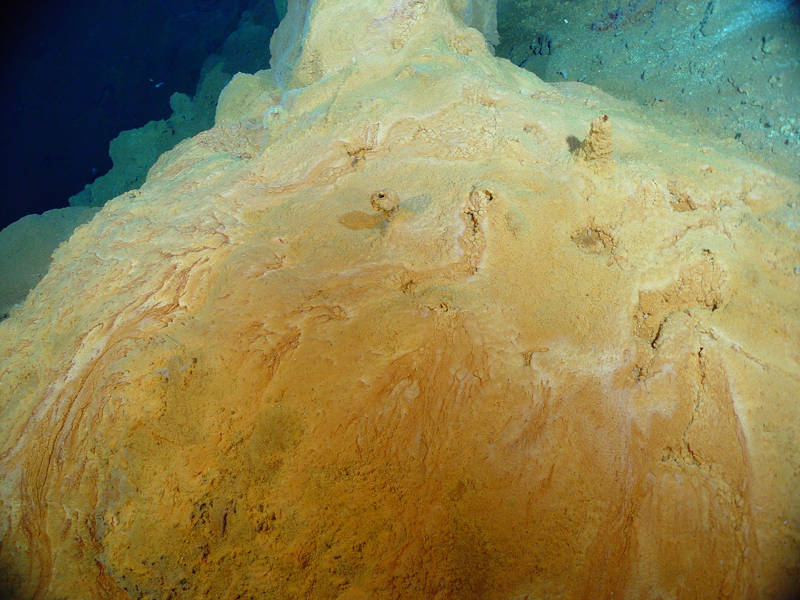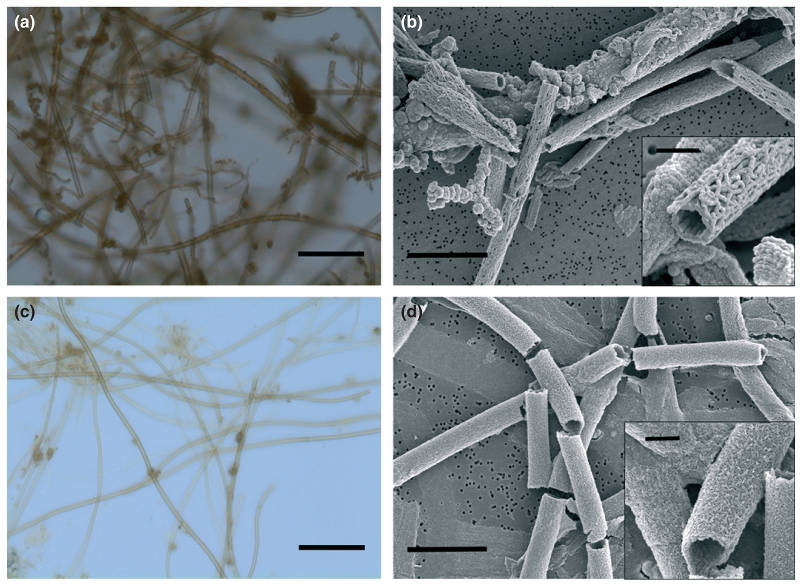
By Craig Moyer - Western Washington University

Photograph of iron-oxide-encrusted microbial mat collected using a remotely operated vehicle at Yellow Top Vent, Northwest Eifuku. Image from Emerson and Moyer, 2010. Download larger version (jpg, 3.3 MB).
Deep-sea hydrothermal vents are dynamic and extremely productive biological ecosystems supported by chemosynthetic microbial primary production. In the absence of photosynthesis, these microorganisms derive energy via the oxidation of reduced chemicals emitted in hydrothermal fluids. In contrast to other strategies for microbial chemosynthesis at hydrothermal vents, iron oxidation has only recently been studied.
By weight, iron is the most abundant element in the Earth and has vast potential as an energy source for microbes via chemolithoautotrophy (obtaining energy from the oxidation of inorganic compounds) coupled to iron oxidation. However, iron’s ability to act as an electron donor for the biotic fixation of carbon dioxide (CO2) in neutrophilic (neutral pH) environments is limited by the rapid abiotic oxidation of ferrous to ferric iron in the presence of oxygen, so it is considered a fleeting meal.
In some diffuse vent areas on NW Eifuku seamount, iron-oxidizing bacterial mat grows so thick it covers the seafloor, and even tumbles downslope like little snowballs. Video courtesy of Submarine Ring of Fire 2004 Expedition, NOAA/PMEL. Download (mp4, 7.4 MB)
Despite this ephemeral nature of iron as an energy source, iron-oxidizing bacteria (“FeOB”) have been identified in many hydrothermal habitats and have been shown to flourish when sharp redox gradients are present with hydrothermal fluids high in CO2 and reduced iron. The recently discovered Zetaproteobacteria represent a novel class that contains both diverse and abundant contributors to deep-sea FeOB communities. They are considered ecosystem engineers due to their integral role in the formation of microbial mats allowing for more efficient iron-feeding. The Zetaproteobacteria are also suspected of undergoing ‘microbial gardening’ by the vent shrimp Opaepele loihi, which shows their potential impact upon higher trophic levels.

Micrographs showing the overall similarity between representative samples of marine and freshwater sheaths inside microbial mats. The top panels show (a) a light micrograph of a sample taken from a hydrothermal vent with a syringe sampler (J2-481-BS4) and (b) a scanning electron microscope (SEM) image of this sample that shows the fine structure of the sheaths. The lower panels show a sample taken from a local freshwater iron-seep in Maine morphologically dominated by Leptothrix ochracea: (c) a light micrograph and (d) an SEM image showing fine structure of the sheaths. Scale bars for a and c are 15 µm; b and d 5 µm with panel insets 1 µm. Image from Fleming et al., 2013. Download larger version (jpg, 2.4 MB).
A recent study analyzed a number of iron-rich microbial ecosystems in a global survey and identified several unique operational taxonomic units or OTUs (akin to species). Of these, two were ubiquitous and thereby considered cosmopolitan throughout the Pacific Ocean. We are now pursuing a genomics approach to understand why these two populations are ecologically more relevant and evolutionarily more successful than the plethora of other Zetaproteobacteria that have been detected.
Distinct microbial mat types associated with varying cell morphologies (e.g., tubular sheaths versus twisted helical stalks) have also been consistently observed. Fine-scale microscopy and community DNA fingerprinting analyses of distinct mat morphotypes provide evidence that various mats also represent distinct distributions of closely related microbial populations.

Venn diagram comparing OTU distribution between Loihi Seamount (A), the Southern Mariana Trough (B), and the southern Pacific Ocean group (Vailulu’u Seamount/Tonga Arc/East Lau Spreading Center/Kermadec Arc) (C). Ubiquitous OTUs are highlighted in boldface. Image from McAllister et al., 2011. Download larger version (jpg, 307 KB).
Furthermore, similar morphological structures can still be identified hundreds of millions of years back in the rock record, making them of paleontological, and potentially of exobiological, interest. As knowledge of extant iron-oxidizing populations grow, it is possible they will also help to inform us of environmental change in past Earth history.
From a practical standpoint, these organisms might be thought of as “micro-machines,” spinning out threads of iron oxyhydroxide that coalesce in as yet unknown ways, helping to build these characteristic microbial mats. These oxides are known to be highly reactive with a range of other metals, organic compounds, and nutrients, thus impacting many other biogeochemical cycles.